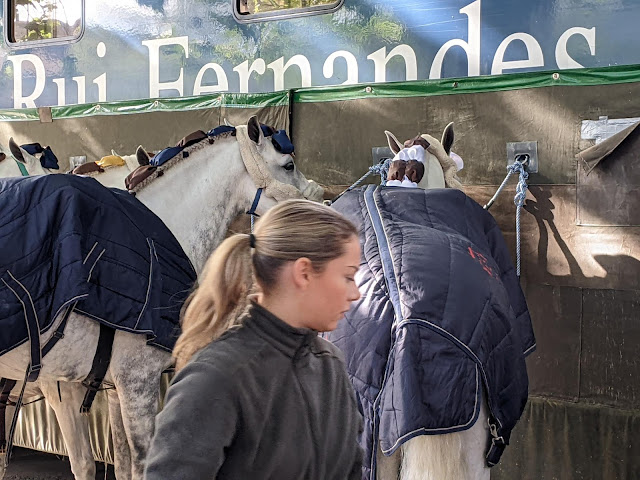This post is not a discussion on the morality of bullfighting. My interest here, as a horseman, is the horse and the part it plays in bullfighting. This post is for those who seek education to bring more quality to future debates.
*
18th April 2022, 8.30 am, on a tiny piece of grass surrounded by parked cars & people, behind the arena of Arles, horses were warmed up by their respective owners: Rui Fernandes, Guillermo Hermoso De Mendoza & Diego Ventura.
 |
| R Fernandes & D Ventura warming up |
 |
| H De Mendoza warming up |
These riders are known as Rejoneadores. This term comes from Rejon which is a knife attached to a spear. A bullfight Rejon always involves horses. Furthermore, in a bullfight where a Rejon is used, the bull will always be killed in the arena as opposed to somewhere else.
 |
| Circled in blue is the Rejon. In this picture, the bull has just entered the arena. At this stage of the bullfight, the Rejoneadore is riding a horse with exceptional endurance to run. |
For two and a half hours i watched the horses getting prepared and warmed up ahead of the fight at 11am. i remained backstage for the duration of the whole event which lasted two hours. From there, i watched grooms at work, horses getting mentally ready, horses going to the arena and the horses coming back from the same place. The grooms started work at 1am.
.jpg) |
| At 19 y o, this Lusitano was the oldest of the string at Diego Ventura's stable. Head-groom, Paco, described him as 'THE best'. |
.jpg) |
| The 19 y o Lusitano getting last minute prep ... |
.jpg) |
| ... before being lead to the arena. |
.jpg) |
| This 6 y o Lusitano was the youngest of Diego Ventura's string. |
.jpg) |
| This is a Lusitano X Arab. A fast and endurant horse which is ridden during the first stage of a bullfight. The different stages are explained further below. |
.jpg) |
| Horses calmy waiting. |
Each Rejoneadore had a string of about 10 horses. 80% were entire of which 50% at stud. Each stable had them tied up close to each other to the lorry, saddled and ready to go. 30 horses at very close proximity to each other, there was a lot of testosterones. There were some opinions expressed but, not one kicked or bit another. To me this is a first indication that these horses have a purposeful life. They know the rules and what is expected of them. There was good energy about them.
 |
| The majority of horses were males. The few mares around were kept well separated. |
 |
| Grooms at work at Rui Fernandes's stable. |
 |
| Entire horses kept at close proximity of each other, not one kicked or bit another. |
In France, Spain & Portugal, bullfighting season spans from February to the end of November.
* A
bullfight Rejon has 3 parts - The
first part is called Tercio de Salida. This is when the bull comes out into the
arena and the Rejoneador uses the Rejon. For this first part, the horse is
chosen for its stamina to run. The
second part is called Tercio de Banderillas. The Rejoneador uses his more
advanced horses with more spectacular dressage movements. The
last part is called Ultimo Tercio or Tercio de Matar. This is when the bull is
killed. Each
horse is ridden between 2 to 3 mins whilst in the arena. From
the moment the bull enters the arena to the moment it dies, an average of 15
mins has elapsed. From this point, in Arles, a team of two Comtois driven side on, goes to work. The Comtois is one of the nine heavy horse breeds of France. Nowadays, they come in a variety of sizes depending on their activity. The smaller ones are ridden in dressage and the taller ones are usually driven.
Once dead, the bull is dragged at the trot out of the arena through an ancient long
curved narrow tunnel in the shape of an L.
i was invited into
the tunnel to appreciate the intricacy of the operation into this narrow L-shaped tunnel . A lack of momentum and
the horses would get stuck in the 90 degrees turn and too much speed and the
outer horse would cut the corner and prevent the other one from going through.
In my circle of horseman friends, almost all those who own and work cattle also love them, take them to slaughter, eat them and love bullfighting. It is a fact and there is no ambiguity about it. The picture above was, i believe, taken at the end of the third part of a bullfight a.k.a. Ultimo Tercio. i see a horse which is listening and relaxed. For
this to happen, in my experience with horses, there must be true understanding between the rider
and the horse. This implies consistency, excellence and fairness. Without
consistency, the horse will be scattered. Without excellence, the horse will
physically not make it. Without fairness, the horse will break down. i leave you with this last thought. The current evolutionary theorist’s view of life on earth is that there is one ‘single tree of life’. All species are genetically related to all others. A banana and a human have approximately 50% overlap in their DNA.
|













No comments:
New comments are not allowed.